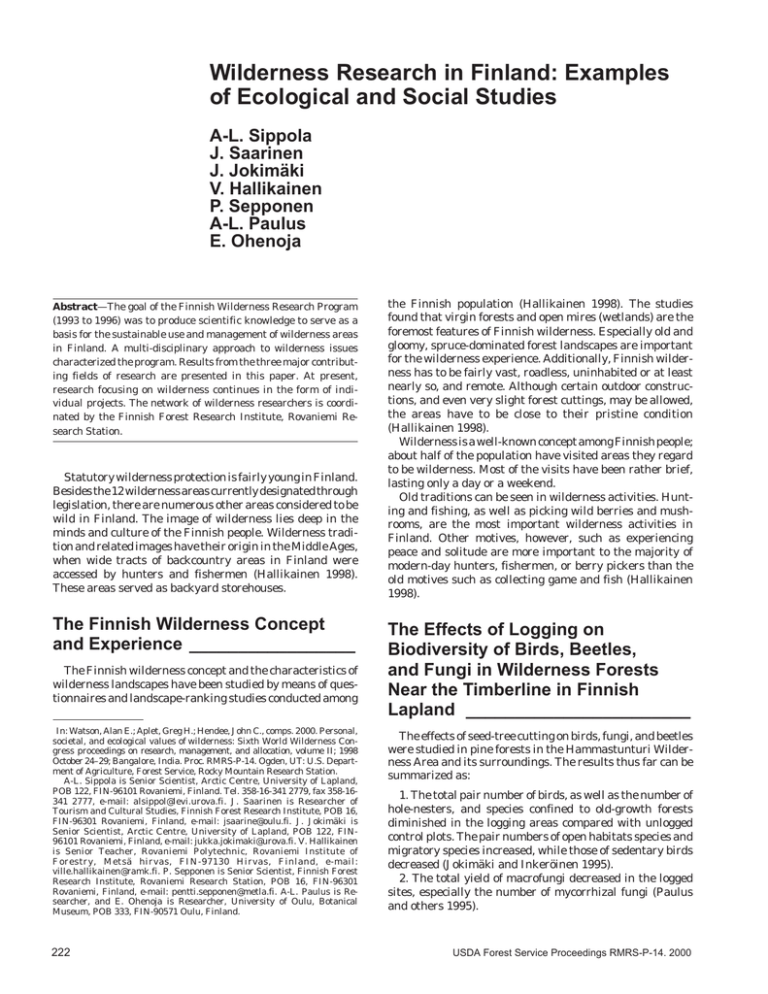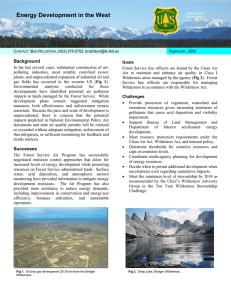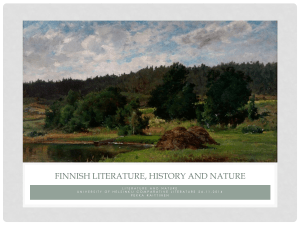Wilderness Research in Finland: Examples of Ecological and Social Studies A-L. Sippola
advertisement

Wilderness Research in Finland: Examples of Ecological and Social Studies A-L. Sippola J. Saarinen J. Jokimäki V. Hallikainen P. Sepponen A-L. Paulus E. Ohenoja Abstract—The goal of the Finnish Wilderness Research Program (1993 to 1996) was to produce scientific knowledge to serve as a basis for the sustainable use and management of wilderness areas in Finland. A multi-disciplinary approach to wilderness issues characterized the program. Results from the three major contributing fields of research are presented in this paper. At present, research focusing on wilderness continues in the form of individual projects. The network of wilderness researchers is coordinated by the Finnish Forest Research Institute, Rovaniemi Research Station. Statutory wilderness protection is fairly young in Finland. Besides the 12 wilderness areas currently designated through legislation, there are numerous other areas considered to be wild in Finland. The image of wilderness lies deep in the minds and culture of the Finnish people. Wilderness tradition and related images have their origin in the Middle Ages, when wide tracts of backcountry areas in Finland were accessed by hunters and fishermen (Hallikainen 1998). These areas served as backyard storehouses. The Finnish Wilderness Concept and Experience _________________ The Finnish wilderness concept and the characteristics of wilderness landscapes have been studied by means of questionnaires and landscape-ranking studies conducted among In: Watson, Alan E.; Aplet, Greg H.; Hendee, John C., comps. 2000. Personal, societal, and ecological values of wilderness: Sixth World Wilderness Congress proceedings on research, management, and allocation, volume II; 1998 October 24–29; Bangalore, India. Proc. RMRS-P-14. Ogden, UT: U.S. Department of Agriculture, Forest Service, Rocky Mountain Research Station. A-L. Sippola is Senior Scientist, Arctic Centre, University of Lapland, POB 122, FIN-96101 Rovaniemi, Finland. Tel. 358-16-341 2779, fax 358-16341 2777, e-mail: alsippol@levi.urova.fi. J. Saarinen is Researcher of Tourism and Cultural Studies, Finnish Forest Research Institute, POB 16, FIN-96301 Rovaniemi, Finland, e-mail: jsaarine@oulu.fi. J. Jokimäki is Senior Scientist, Arctic Centre, University of Lapland, POB 122, FIN96101 Rovaniemi, Finland, e-mail: jukka.jokimaki@urova.fi. V. Hallikainen is Senior Teacher, Rovaniemi Polytechnic, Rovaniemi Institute of Forestry, Metsä hirvas, FIN-97130 Hirvas, Finland, e-mail: ville.hallikainen@ramk.fi. P. Sepponen is Senior Scientist, Finnish Forest Research Institute, Rovaniemi Research Station, POB 16, FIN-96301 Rovaniemi, Finland, e-mail: pentti.sepponen@metla.fi. A-L. Paulus is Researcher, and E. Ohenoja is Researcher, University of Oulu, Botanical Museum, POB 333, FIN-90571 Oulu, Finland. 222 the Finnish population (Hallikainen 1998). The studies found that virgin forests and open mires (wetlands) are the foremost features of Finnish wilderness. Especially old and gloomy, spruce-dominated forest landscapes are important for the wilderness experience. Additionally, Finnish wilderness has to be fairly vast, roadless, uninhabited or at least nearly so, and remote. Although certain outdoor constructions, and even very slight forest cuttings, may be allowed, the areas have to be close to their pristine condition (Hallikainen 1998). Wilderness is a well-known concept among Finnish people; about half of the population have visited areas they regard to be wilderness. Most of the visits have been rather brief, lasting only a day or a weekend. Old traditions can be seen in wilderness activities. Hunting and fishing, as well as picking wild berries and mushrooms, are the most important wilderness activities in Finland. Other motives, however, such as experiencing peace and solitude are more important to the majority of modern-day hunters, fishermen, or berry pickers than the old motives such as collecting game and fish (Hallikainen 1998). The Effects of Logging on Biodiversity of Birds, Beetles, and Fungi in Wilderness Forests Near the Timberline in Finnish Lapland _______________________ The effects of seed-tree cutting on birds, fungi, and beetles were studied in pine forests in the Hammastunturi Wilderness Area and its surroundings. The results thus far can be summarized as: 1. The total pair number of birds, as well as the number of hole-nesters, and species confined to old-growth forests diminished in the logging areas compared with unlogged control plots. The pair numbers of open habitats species and migratory species increased, while those of sedentary birds decreased (Jokimäki and Inkeröinen 1995). 2. The total yield of macrofungi decreased in the logged sites, especially the number of mycorrhizal fungi (Paulus and others 1995). USDA Forest Service Proceedings RMRS-P-14. 2000 3. Wood-rotting fungi were studied at logging sites up to 40 years old. Only half of the original number of old-growth forest species were found among the logging waste on the oldest logging sites. However, residual logs from before logging activity still hosted the majority of the pristine forest species. Endangered species demonstrated different degrees of ecological tolerance to logging: some survived in the residual logs, some had disappeared, and some were able to invade the logging waste (Sippola and Renvall 1998). 4. The total number of beetles increased immediately after logging, especially the number of cambiovores and openhabitat species. On 15 year old logging sites, the species composition of general species had changed considerably. Also, the number of rare species diminished in the course of time (Sippola and Kallio 1995). The effects of logging are very much dependent on the methods applied and the intensity of treatments. Important structural elements such as number and diameter of living and dead trees retained on the sites, and the size and frequency of logging treatments, are crucial in determining the effects of logging. Social Carrying Capacity and the Development of Recreation in Wilderness Environment _________ As national park and wilderness managers are preparing to deal with increasing numbers of recreationists and tourists in their areas, knowledge is needed about how visitors respond to encountering other people in various places within the parks and wilderness areas. During the summer of 1992, backpackers were interviewed in the Urho Kekkonen National Park in northeastern Finland (Saarinen 1998). Response to encounters with other visitors is dependent on whether the encounter is in the wilderness or in frontcountry zones, the size of the group encountered, and whether the group encountered is composed of foreigners or Finns. A majority (nearly 80 percent) expressed preference for some level of contact with others in the wilderness zones of the National Park. Backpackers were more active in initiating social interaction in wilderness zones, where the pressures of recreational use and the numbers of encounters are lower, than in the nonwilderness zone. Attitudes toward contacts with individual backpackers (the majority of those interviewed considered it pleasant) and small and large groups (large groups were less pleasant) were as USDA Forest Service Proceedings RMRS-P-14. 2000 expected. The different reactions to domestic and foreign backpackers are more difficult to interpret. In general, interaction with foreign visitors is less often rated as pleasant. Contacts between backpacker groups of up to three people are seldom unpleasant experiences. Generally, the normative call for greetings and interaction presumes a common language. Owing to language barriers, it is more difficult to establish warm social contacts or any contact at all with foreign visitors (Saarinen 1998). The attitudes shown toward different user groups were found to depend on traditions and expectations concerning social interaction. A majority of visitors indicated that interaction with other backpackers is generally a pleasurable experience, but certain cultural customs apply. Factors such as tradition (culture) and interaction are not independent; the tradition generally regulates social interaction, and interaction causes and strengthens tradition and norms. In the future, it would be desirable to develop greater understanding of social meanings, the role of interaction and language, and their relationship to the establishing and manifestation of social norms. This suggests the need for a more qualitative approach. Social carrying capacity, as well as many other capacity judgments, may be greatly dependent on the cultural context of the judgments, how people relate to specific places, and what values and meanings those places reveal to them (Saarinen 1998). References _____________________ Hallikainen, V. 1998. The Finnish wilderness experience. Research Papers. The University of Joensuu, Faculty of Forestry, Finnish Forest Research Institute. Dissertation. Jokimäki, J.; Inkeröinen, J. 1995. Effects of forestry on wilderness bird assemblages. In: Sippola, A-L.; Alaraudanjoki, P.; Forbes, B.; Hallikainen, V., eds. Northern wilderness areas: ecology, sustainability, values. Arctic Centre Publications. 7: 52-58. Paulus, A-L.; Ohenoja, E.; Tikkinen, S.; Roitto, M.; Sippola, A-L. 1995.The influence of forest felling on the fruitbody production of larger fungi in Northern Lapland. In: Sippola, A-L.; Alaraudanjoki, P.; Forbes, N.; Hallikainen, V., eds. Northern wilderness areas: ecology, sustainability, values. Arctic Centre Publications. 7: 44-51. Saarinen, J. 1998. Cultural influence on response to wilderness encounters: a case study from Finland. International Journal of Wilderness. 4(1): 28-32. Sippola, A-L.; Kallio, R. 1995. Species composition of beetles (Coleoptera) in different habitats within old-growth and managed forests in Finnish Lapland. In: Sippola, A-L.; Alaraudanjoki, P.; Forbes, B.; Hallikainen, V., eds. Northern wilderness areas: ecology, sustainability, values. Arctic Centre Publications. 7: 59-77. Sippola, A-L.; Renvall, P. 1998. Wood-decomposing fungi and seedtree cutting: a 40-year perspective. Forest Ecology and Management. 115(2-3): 183-201. 223







